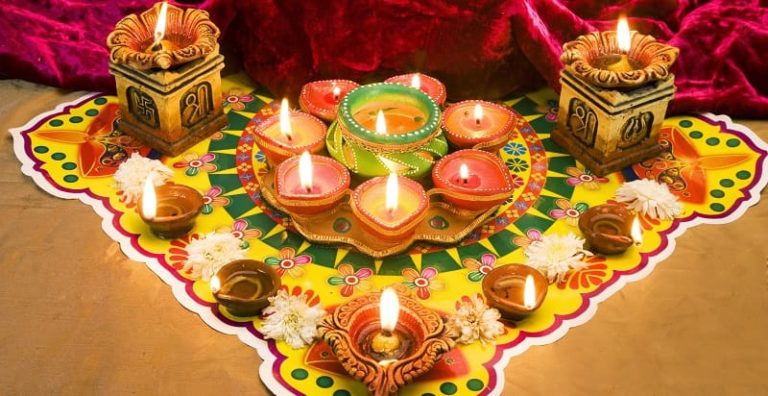Diwali, the festival of lights, holds a profound connection with Lord Shree Ram, symbolizing the triumph of light over darkness, good over evil. It commemorates the return of Lord Ram, the seventh avatar of Vishnu, to his kingdom of Ayodhya after defeating the demon king Ravana. The lighting of lamps and fireworks during Diwali signifies the people’s joyous welcome for their beloved prince. This celebration not only honors a cherished moment in Hindu mythology but also embodies the enduring values of righteousness and the eternal victory of virtue.
Diwali: The Festival of Lights
Diwali, commonly known as Deepavali, is named after a beautiful fusion of two Sanskrit terms: ‘deepa,’ symbolizing the radiant lamp or light, and ‘avali,’ representing an enchanting series. This vibrant festival unfolds over five joyous days, with its pinnacle on the tranquil new moon night within the Hindu lunar month of Kartika. Homes and streets are adorned with rows of oil lamps or diyas, symbolizing the victory of light and righteousness. Fireworks, colorful rangoli designs, and the exchange of sweets and gifts are an integral part of the festivities.

Lord Shree Ram: The Ideal King
Lord Shree Ram, the revered protagonist of the epic Ramayana, stands as a symbol of unparalleled virtue, ethics, and ethical principles. His life and wisdom serve as a wellspring of motivation for countless individuals. Conceived to King Dasharatha and Queen Kaushalya in the splendid city of Ayodhya, Lord Shree Ram embarked on a 14-year sojourn in the wilderness, encountering a multitude of trials and hardships. His unflinching commitment to dharma (duty) and his relentless quest for truth and justice establish him as an esteemed icon in the realm of Hinduism.
The Ramayana: The Epic Tale
The connection between Diwali and Lord Shree Ram is intricately woven through the pages of the Ramayana. The sage Valmiki’s timeless masterpiece unveils the captivating saga of Lord Shree Ram’s life and exploits, with the pinnacle of the Ramayana being the valiant rescue of Sita, Lord Shree Ram’s beloved wife, from the clutches of the demon king Ravana.
The Return of Lord Shree Ram
Diwali is celebrated to commemorate Lord Shree Ram’s return to Ayodhya after 14 years of exile, with his loyal brother Lakshman and the devoted Hanuman by his side. The people of Ayodhya welcomed him with immense joy and enthusiasm, lighting rows of lamps and bursting firecrackers to illuminate his path and celebrate his return. The lighting of diyas during Diwali symbolizes the triumph of light over darkness and the victory of good over evil, echoing the return of Lord Shree Ram to his kingdom after defeating Ravana, the embodiment of evil.
Ravana’s Defeat and the Triumph of Good
The climax of the Ramayana revolves around the battle between Lord Shree Ram and Ravana, the ten-headed demon king of Lanka. Ravana had abducted Sita, Lord Shree Ram’s beloved wife, and taken her to his kingdom. This led to a fierce war, which culminated in the destruction of Ravana by Lord Shree Ram’s divine bow, the Shiva Dhanush. The defeat of Ravana is celebrated as the victory of righteousness over evil, a theme that resonates with the essence of Diwali.
The Symbolic Significance of Diwali
Diwali represents a profound spiritual and moral message. It symbolizes the complete elimination of one’s inner shadows, the dispelling of ignorance and ego, making way for the radiant brilliance of wisdom, knowledge, and virtue to emerge. Lord Shree Ram’s life stands as an exemplary illustration of unwavering commitment to one’s dharma, unwavering dedication to duty, and upholding the utmost ethical principles, even when confronted with adversity.
Ram Lila: The Theatrical Depiction
In various parts of India, the nine days leading up to Diwali are marked by the enactment of the Ram Lila, a theatrical performance of the Ramayana’s key events. These performances are a means of rekindling the connection between Lord Shree Ram and Diwali, allowing people to witness and participate in the drama and emotion of Lord Ram’s life, from his birth to his triumphant return.
Sita, Laxman, and Hanuman: Symbols of Devotion
Sita, Laxman, and Hanuman, the prominent characters in the Ramayana, are also integral to the Diwali celebrations. Sita, as the epitome of devotion and chastity, inspires millions of women to emulate her unwavering dedication to Lord Shree Ram. Laxman, the devoted brother, teaches the values of loyalty and selfless service. Hanuman, the loyal devotee with boundless strength and devotion, embodies the spirit of unwavering faith.
A Universal Celebration
Emerging from its Hindu roots, Diwali elegantly transcends religious confines, striking a chord with individuals from a myriad of cultural heritages and faiths, while perpetuating a timeless narrative of illumination, optimism, and the conquest of virtue over malevolence, nurturing a collective spirit of togetherness, comprehension, and shared human principles.
Also read – Is There Any Evidence Of Ramayana? Know About That
Also read – All About Shree Ram and His Life
Conclusion
In the radiant tapestry of Indian culture, the connection between Diwali and Lord Shree Ram resonates profoundly. Diwali, the festival of lights, symbolizes the victory of light over darkness, righteousness over evil. It commemorates Lord Ram’s return to Ayodhya after vanquishing Ravana, restoring dharma. The lamps we light represent the enlightenment of our souls. Diwali embodies the timeless message of hope, righteousness, and the enduring legacy of Lord Shree Ram, emphasizing the eternal values that guide our lives.
Also read – Explore the Muktinath Temple: A Spiritual Haven
